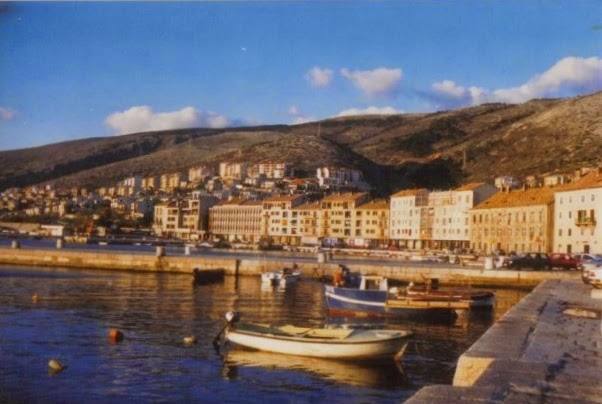What happened to "Senjko"
SENJ
THIS is Senj, on Croatia's Adriatic coast, situated south of Rijeka and north of Split. An old town with a history going back to Roman times when this was the province of Dalmatia, and further, it looked peaceful enough in the early evening sun when we came over the hills from Zagreb.
It might seem strange that our Workers Aid convoy which was heading for Tuzla, in north central Bosnia, in the early Spring of 1994, should have to head first for the coast, then south along sometimes narrow unlit roads by the sea to Split, before sitting in a dusty car park for days, awaiting permission to head up into the mountains and north again, partly taking makeshift tracks, to reach our mining town destination.
It was odd, considering a much-shorter and more direct route by motorway crossed the Posavina valley between Zagreb and Tuzla. But the UN 'protection force' (UNPROFOR), which had a mandate to protect humanitarian aid convoys in Bosnia and effectively controlled the roads, had other ideas, and so we were obliged to take the scenic route.
And so to Senj, which though not unaffected by the war, seemed relatively peaceful, indeed perhaps over-quiet.
It had not always been so. Indeed to take one period:
The military captaincy of Senj was established in 1469 in order to defend against the invading Ottoman and Venetian armies. The town sheltered thousands of refugees from nearby occupied areas. The Nehaj Fortress was completed in 1558 on the hill Nehaj, which at the time was outside of town. Today it is wholly within the town's borders. The wars with the Ottomans lasted well into the 17th century. During this time the Uskoks lived in Senj and occupied the fortress. They served an important purpose during the wars since they had small units of men rowing swift boats that proved to be very effective guerrilla forces. However, after the Uskok War with Venice, which ended in 1617, they were forbidden to settle in the area
Indeed, these Uskoks, from a word meaning 'to leap', had come over the mountains as refugees from Ottoman rule, but became a byword for guerrilla war and piracy, against both Turks and Venetians. (I should also mention that in 1494, Senj had one of the first printing presses in south-east Europe, so it had its cultural side),
Since the uskoks were checked on land and were rarely paid their annual subsidy, they resorted to acts of piracy.[14] Large galleys could not anchor in the bay of Senj, which is shallow and exposed to sudden gales. So, the uskoks fitted out a fleet of swift boats, which were light enough to navigate the smallest creeks and inlets of the shores of Illyria. Moreover, these boats were helpful in providing the uskoks a temporary landing on shore. With these they were able to attack numerous commercial areas on the Adriatic. The uskoks saw their ranks swell as outlaws from all nations joined them. Eventually, the whole city of Senj lived from piracy. The expeditions were blessed in the local church and the monasteries of the Dominicans and the Franciscans received tenths from the loot.[15]Thanks to Wikipedia.
The swashbuckling period eventually came to an end, but Senj was yet to play a heroic role in a much later conflict:
In the fall of 1943, during World War II, when Fascist Italy capitulated, the Partisans took control of Senj and used it as a supply port. Subsequently, the Luftwaffe started bombarding the city. By the end of the year they had demolished over half of the buildings in town and inflicted heavy civilian casualties.
It just so happened that this weekend I thought I'd change my cover photo on Facebook, and decided the nice picture of Senj above would be a pleasant sight. Having done so, I thought I'd find out more about the place, and discovered that among the famous people born there was a man called Vladimir Copic. By a coincidence, today is his birthday - it was March 8, 1891, to be exact. Copic, a leading member of the pre-war Yugoslav Communist Party, was known as "Senjko".
VLADIMIR COPIC known as Senjko
According to Wikipedia:
Vladimir "Senjko" Ćopić (Senj, 8 March 1891 –Moscow, 19 April 1939) was a Croatian politician, communist, one of the leaders of the Communist Party of Yugoslavia. During the Spanish Civil War, in the period from 1937 to mid-1938, he was the commander of the XV International Brigade.An entry on the Spartacus education site says:
Like General "Gal", he had been conscripted into the Austro-Hungarian army during World War I, and subsequently captured by the Russians.[1]
His brother, Milan Ćopić, was in the International Brigades' prison at Camp Lucász.
A member of the Communist Party he volunteered to fight for the Popular Front government during the Spanish Civil War. Copic arrived in Spain in 1937 and joined the other International Brigades at Albacete. Copic was appointed commander of the 15th International Brigade and served at Brunete in July 1937. Copic was killed in 1938.http://spartacus-educational.com/SPcopic.htm
Notice a small discrepancy. This latter site just says Copic was "killed in 1938", leaving us to think he might have fallen in battle in Spain. But the Wikipedia entry tells us he died on April 19, 1939, in Moscow. Of his wounds perhaps?
In actual fact, though several accounts by Spanish civil war veterans are critical of Copic's command, accusing him of sending poorly-equipped units into engagements they could not win, it seems the reason he was recalled to Moscow was to replace other leaders of the Yugoslav party in exile who had fallen victim to the Stalinist purges. And on April 19, 1939, it was 'Senjko's turn, accused of being a "British agent", and executed.
http://communismeetconflits.over-blog.com/2013/10/vladimir-copic-commandant-de-la-15e-brigade-internationale.html



0 Comments:
Post a Comment
<< Home